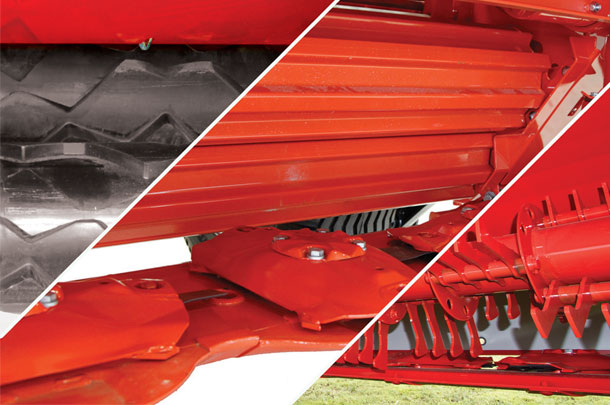Many producers stick with what they have used in the past, since it is a known and trusted machine. However, you need to ask yourself:
- What is the best type of conditioner to use in my conditions?
- What are the benefits and drawbacks to each style?
- What gains can be made when selecting one type of conditioner system versus another?

The first option available is no conditioner. This is just a cutterbar only and is common for areas where drydown is not an issue or when the hay is going to be chopped fairly soon at a relatively high moisture. This option saves on equipment expense.
Machines without conditioners require fewer components, so they are less expensive to purchase and maintain. Additionally, with fewer moving parts during operation, it reduces the horsepower requirements and lowers fuel consumption, thus saving operational costs. If your operation does not require the crop to be conditioned, this is a great option to save you money. However, this is not the case for many hay and forage growers, especially when putting up dry hay.
In many situations, you will see clear benefits from a conditioner. The purpose of any conditioner is to create openings in the outer cuticle layer of the stem of the crop. These openings allow moisture to escape faster so the stem dries at a similar rate to the leaves of the plant.
Without breaking this layer, moisture can only leave the stem from the cut end, which is a small area compared to all the openings in the leaves where the plant normally breathes. If the stems and the leaves do not dry at the same rate, forage quality can be impacted by losing leaves during baling if they become too dry and brittle. Alternatively, if the stems still contain too much moisture, this can result in spoiled or moldy hay during storage.
Assuming your haying operation would benefit from conditioning the crop, there are generally two types of conditioners to consider: finger or rollers.
Finger conditioners have one rotor with tines/flails/spokes/impellers or some sort of fingers mounted to the rotor depending on brand terminology. Finger-type conditioners force the crop to rub against other crop, the conditioner panel and the fingers themselves creating additional openings in the outer layer of the stem.
Roller conditioners generally have a set of two rolls (these rolls can be rubber or steel) that feed the crop through the machine. There are different configurations used for roller conditioners that each have a slightly different method for creating openings in the outer layer of the stems. Rollers with lugs or a tread pattern that intermesh put a crimp in the stems every so often.
This conditioning action can be observed by picking up a stem of the crop that has gone through the machine. The stem should have a kink every couple of inches where the lugs crimped it. Other variations of roller conditioners use rolls with minimal lugs that do not have a gap between them. The intent of these rollers is to crush or crack the entire length of the stem. In addition, some conditioning systems employ multiple sets of conditioner rolls to create additional crimps every inch or so, increasing the number of openings in the stem.
Regardless of the conditioner type, one of the most overlooked and most important aspects of the conditioner for optimal drydown is the conditioner adjustment. If the conditioner is not adjusted to be aggressive enough in the field, very little conditioning is done, which does not improve drying time. Conversely, if conditioners are too aggressive, the crop can be damaged, resulting in greater losses and often increased drying times. It is important to know how to adjust each type of conditioner to match different crops and field conditions. Often as dew evaporates or comes in, for optimal performance it may be necessary to make adjustments before completing a field.
Generally, to adjust aggressiveness on a finger-type conditioner, a deflector (often called a conditioning panel) controls how much the crop is directed into the conditioning fingers. If the conditioner panel is open, the crop just passes around the fingers; if the panel is fully engaged, the fingers can actually damage the crop by shredding it or stripping off valuable leaves. Additionally, some machines offer different rotor speed options; this is also an important adjustment to ensure the proper amount of conditioning for the crop type and volume.
For roller-type conditioners, the first setting to adjust is the roll gap. This space between rolls will have the greatest impact on how aggressively the crop is conditioned. Making this adjustment is important and can vary based on crop type and volume.
After the roll gap is set, the next adjustment is the roll tension. Whether using springs, a torsion bar or hydraulics, the amount of pressure needed to push the rolls apart needs to be set. This ensures the crop is conditioned, but still allows the rolls to separate and compensate for variations in crop volume or for rocks and other objects that could otherwise damage the machine.
Generally, when harvesting stemmy, cane-type crops, roller conditioners perform better. They are able to grab the crop and feed it through the rolls better, clearing the cutterbar and providing a better cut quality than finger conditioners. Often roller conditioners are also better in leafy crops like alfalfa, since the rolls can be a little more forgiving on the leaves. An overly aggressive setting on a finger conditioner can strip leaves off, while with a roller conditioner, it may only bruise them. Finger conditioners excel in grassy crops, as well as lighter crops that do not have strong stems.
All conditioners create some wind when rotating; rolls tend to direct more air forward toward the cutterbar, which can blow down the crop, resulting in poor cut quality. This action can be overcome by the counterintuitive adjustment of slowing the PTO rpm and increasing ground speed to improve cut quality. Finger conditioners can create a slight suction because of how the conditioner rotates. This improves the feeding and cut quality of light or grassy crops.
Conditioning systems can greatly improve efficiency by substantially reducing drying time, but it is important to match the conditioner type to crop and field conditions. You also need to make sure the machine is adjusted properly to ensure optimum performance in the field without damaging the crop. ![]()
PHOTO: Conditioning systems can greatly improve efficiency by substantially reducing drying time, but it is important to match the conditioner type to crop and field conditions. Photo courtesy of Kuhn North America.
Ben Craker is the Senior Product Manager at Kuhn North America. Email Ben Craker.










